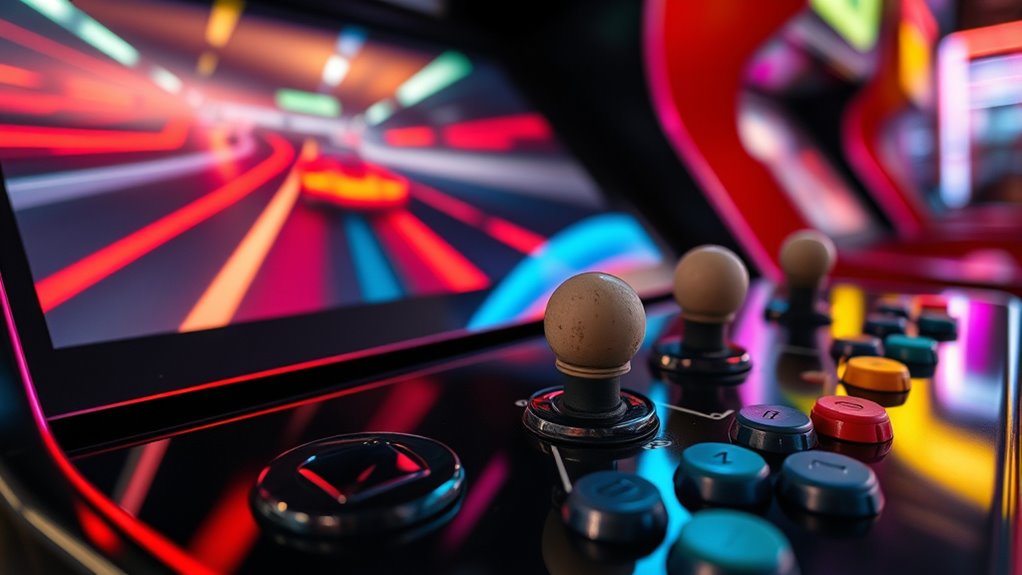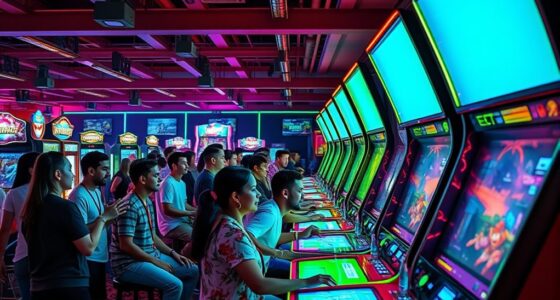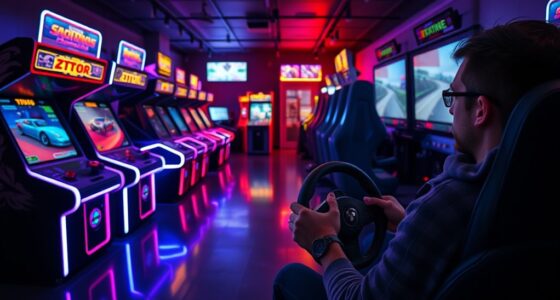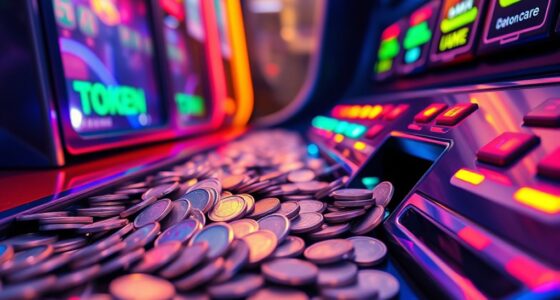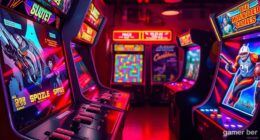The physics behind racing arcade cabinets blend mechanical, hydraulic, and electronic systems to mimic real driving sensations. When you turn the steering wheel or press pedals, sensors detect your movements, and actuators reproduce forces like resistance or vibrations. Hydraulic and mechanical linkages create realistic shifts and tilts, while force feedback adds tactile responses, making you feel road bumps or tire grip. If you want to understand how all these systems work together to produce authentic racing experiences, keep exploring.
Key Takeaways
- Hydraulic and mechanical linkages convert fluid pressure and motor movements into realistic tilts, vibrations, and shifts for immersive feedback.
- Force feedback systems use motors and actuators to simulate steering resistance, road bumps, and tire grip, enhancing realism.
- Sensors detect user inputs and vehicle dynamics, which are synchronized with actuators to produce seamless tactile responses.
- The physics of tire grip and aerodynamics influence vehicle stability and handling, affecting the player’s control and experience.
- Software algorithms calibrate hardware responses, ensuring accurate simulation of real-world racing forces and environmental effects.
The Mechanics of Steering and Pedal Inputs
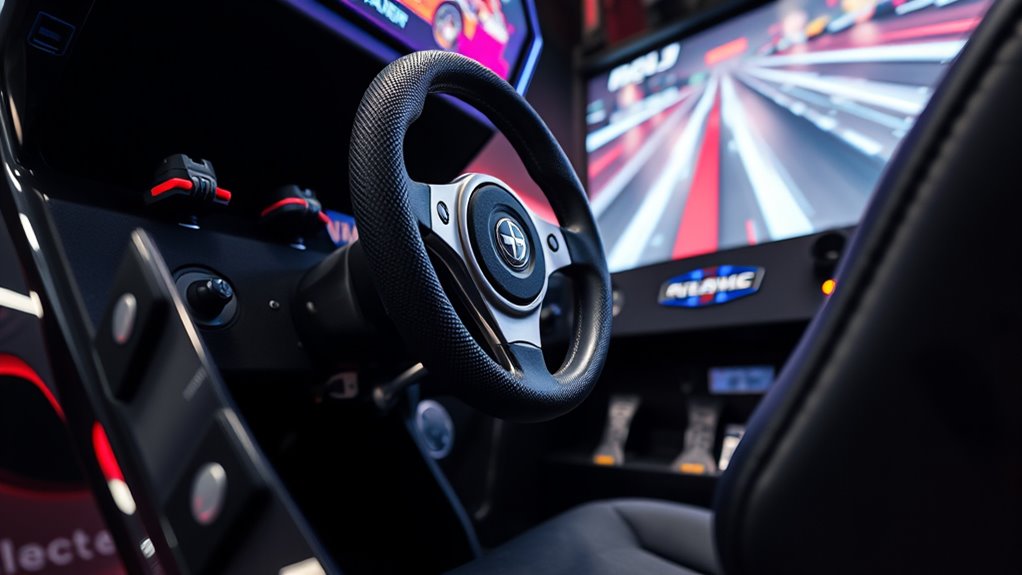
Understanding how steering wheels and pedals work is essential to grasping the mechanics of racing arcade cabinets. Your experience depends heavily on the ergonomic design, which guarantees comfort during extended play. A well-designed wheel and pedal setup provides smooth, responsive input, creating a natural user interface that mimics real driving. The steering wheel translates your turns into precise movements, while the pedals control acceleration and braking, responding instantly to your pressure. These inputs are calibrated to deliver realistic feedback, enhancing immersion. Ergonomics minimizes fatigue and maximizes control, making every race feel authentic. Additionally, recognizing the importance of local tips can help you optimize your setup for better performance and comfort. By understanding how these components work together, you can better appreciate how the mechanics behind the steering and pedal inputs elevate the overall gaming experience, immersing you in the thrill of racing.
Simulating Motion: Hydraulic and Mechanical Systems
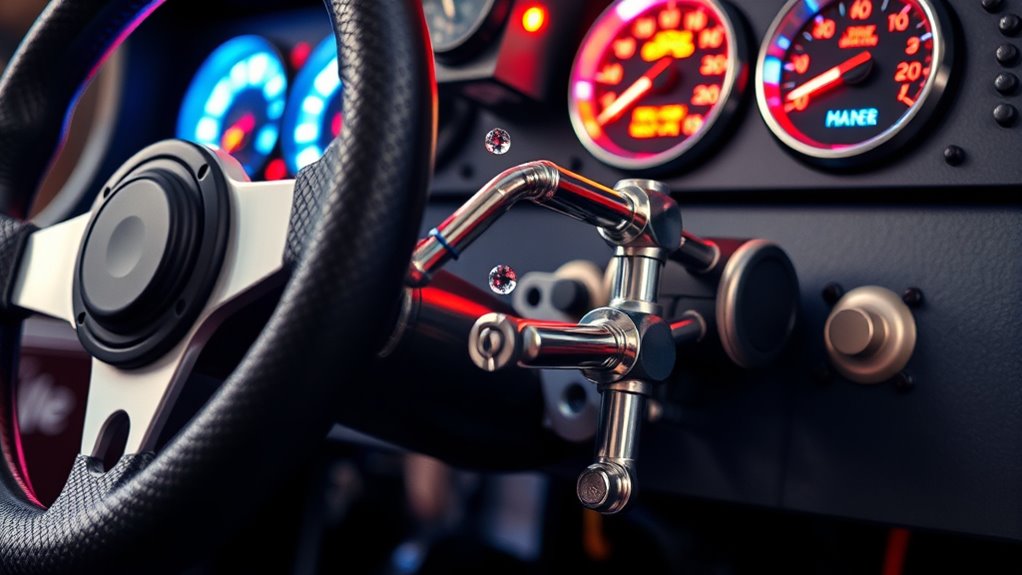
To create an immersive racing experience, arcade cabinets often simulate motion using hydraulic and mechanical systems that mimic real-world forces. Hydraulic systems use hydraulic fluid to generate smooth, powerful movements, pushing or pulling mechanical linkages connected to the seat or cockpit. These linkages translate fluid pressure into realistic tilts, vibrations, and shifts, mimicking the sensation of acceleration, braking, and cornering. Mechanical linkages, on the other hand, directly connect motors to the seat or frame, producing precise movements without fluid. By combining these systems, manufacturers deliver dynamic feedback that enhances realism. The hydraulic fluid’s pressure and flow regulate the intensity of motion, while mechanical linkages ensure quick, reliable responses. Compatibility between systems is crucial for seamless operation and realistic simulation. Together, they create a convincing simulation of the physical forces experienced during high-speed racing.
Force Feedback: Enhancing Realism Through Tactile Response
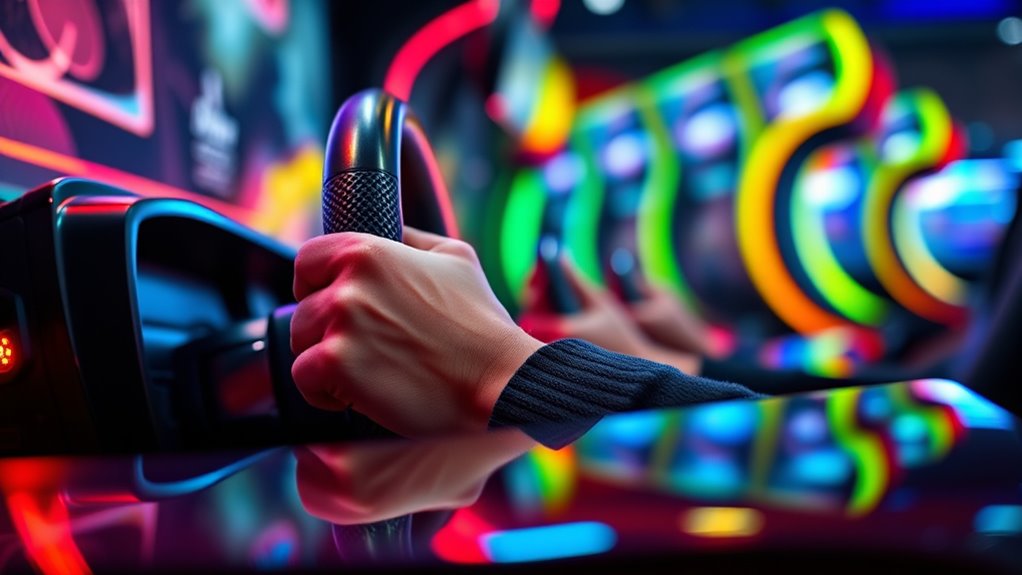
Force feedback systems build on hydraulic and mechanical motion simulations to provide tactile sensations that mirror real-world racing forces. These systems use motors and actuators to generate haptic textures, creating a realistic feel of steering resistance, road bumps, and tire grip. Through carefully designed tactile illusions, you can sense subtle changes in traction or the impact of a sharp turn. The tactile feedback enhances immersion by translating visual cues into physical sensations, making every bump and drift more convincing. By simulating these forces, you gain a richer, more authentic racing experience. The tactile responses are finely tuned to reflect the physics of the vehicle’s interaction with the track, giving you a sense of control and realism that elevates arcade racing beyond simple visual simulation. Additionally, understanding dynamic contrast ratios helps developers craft more immersive feedback systems by mimicking real-time changes in scene brightness and contrast.
The Role of Sensors and Actuators in Virtual Racing
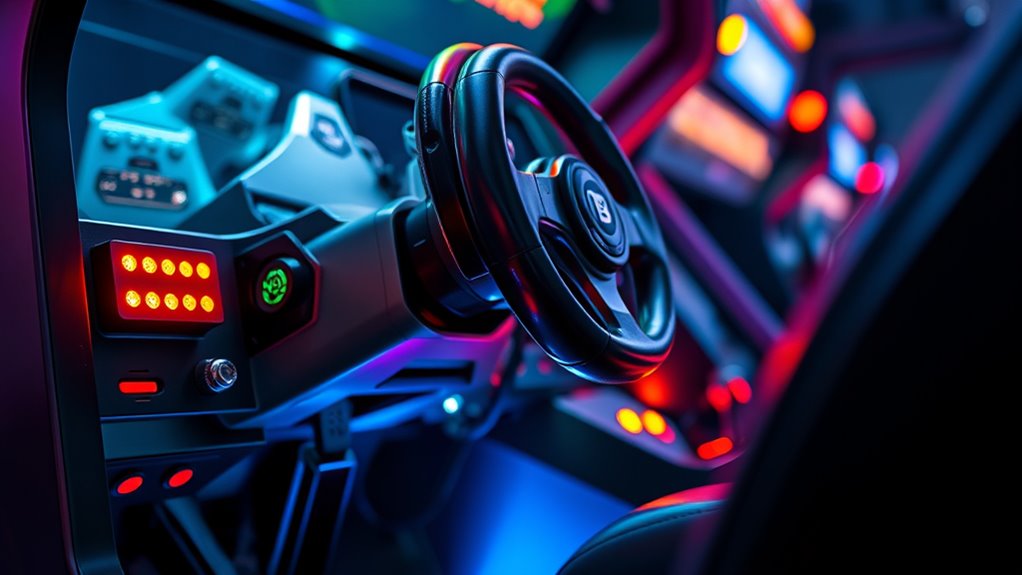
In virtual racing, sensors detect your steering, acceleration, and braking inputs, providing real-time data to the system. Actuators then translate signals into physical responses, like wheel feedback or seat vibrations, enhancing immersion. Understanding how these components synchronize is key to creating a seamless and realistic racing experience. Additionally, utilizing professional-grade equipment can significantly improve the accuracy and overall quality of the simulation.
Sensor Types and Functions
Sensors and actuators are vital components that bring virtual racing experiences to life by creating realistic feedback and interactions. Different sensors detect specific inputs, such as steering angle, pedal pressure, or vehicle acceleration. Accurate sensor calibration guarantees precise data collection, which is essential for realistic gameplay. Data logging helps track sensor performance over time, identifying issues and maintaining responsiveness. Here’s a quick overview of common sensor types:
| Sensor Type | Function | Role in Racing Cabinets |
|---|---|---|
| Potentiometers | Measure rotational position | Track steering wheel movement |
| Load Cells | Detect force or pressure | Measure pedal pressure |
| Accelerometers | Sense acceleration and tilt | Detect sudden movements or impacts |
| Hall Effect Sensors | Measure magnetic field changes | Track rotational movements |
Understanding the importance of sensor calibration ensures that the data collected is accurate and responsive, leading to a more immersive racing experience.
Actuator Dynamics and Control
Have you ever wondered how racing arcade cabinets deliver such realistic feedback? It all comes down to actuator dynamics and control. The actuators generate forces that mimic real driving sensations, and their effectiveness depends on precise calibration. This process, known as actuator calibration, ensures the actuators respond accurately to control signals. Virtual inertia plays a key role here, creating the sensation of weight and resistance, making the feedback feel more authentic. The system constantly monitors sensors to adjust actuator output in real time, maintaining smooth, responsive motion. By managing these factors, the control system creates a convincing sense of speed, grip, and terrain. Additionally, implementing high-quality sound recording techniques can enhance the immersive experience by providing realistic auditory feedback. This seamless interplay between sensors, virtual inertia, and actuators is what immerses you fully into the racing experience.
Synchronization in Racing Systems
Achieving seamless synchronization in virtual racing systems hinges on the precise coordination between sensors and actuators. You need accurate sensor calibration to guarantee signals correctly reflect real-world inputs, preventing discrepancies during gameplay. Proper calibration minimizes errors, making the system respond exactly as intended. Reducing latency is essential; it ensures that sensor data reaches the processor quickly, so actions like steering or braking are reflected instantly. This synchronization relies on fine-tuning both hardware and software components to work in harmony. When sensors are properly calibrated and latency is minimized, your racing experience becomes more immersive and responsive. This tight coordination creates the realistic feedback drivers expect, bringing virtual racing closer to real-world physics and enhancing overall gameplay precision. Additionally, understanding the role of sensors and actuators in the system helps optimize performance and achieve higher levels of realism.
Physics of Vehicle Dynamics and Trajectory Control
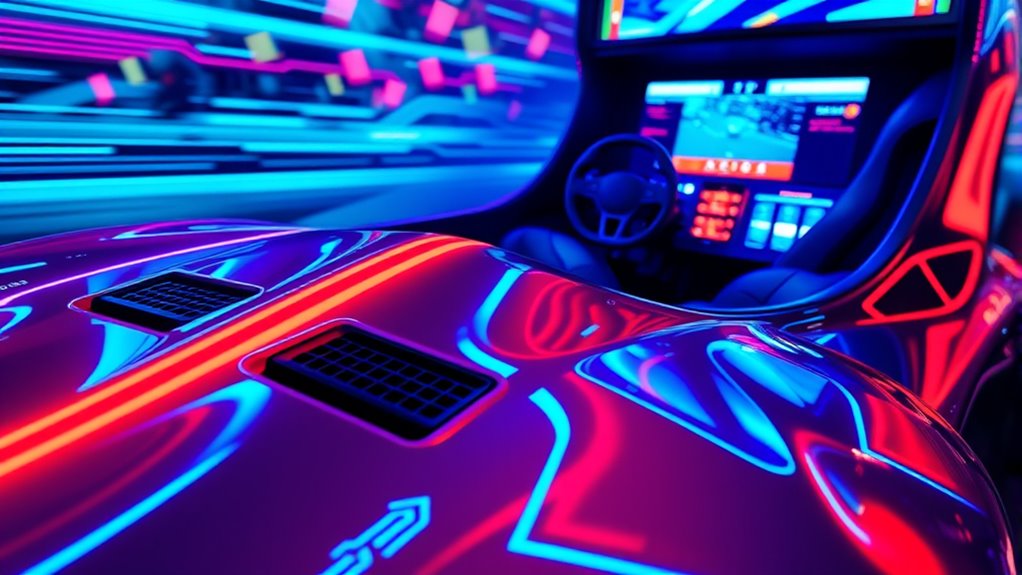
Understanding the physics of vehicle dynamics is essential for mastering trajectory control in racing arcade cabinets. Your ability to steer accurately depends on factors like aerodynamic stability and tire grip. When you turn, the vehicle’s handling relies on how well the tires maintain grip and how aerodynamic forces influence stability. Proper balance prevents skidding and helps you stay on your desired path. Additionally, self-watering features in some advanced gaming setups can simulate real-world environmental conditions, enhancing the immersive experience.
The Impact of Screen Technology and Visual Cues
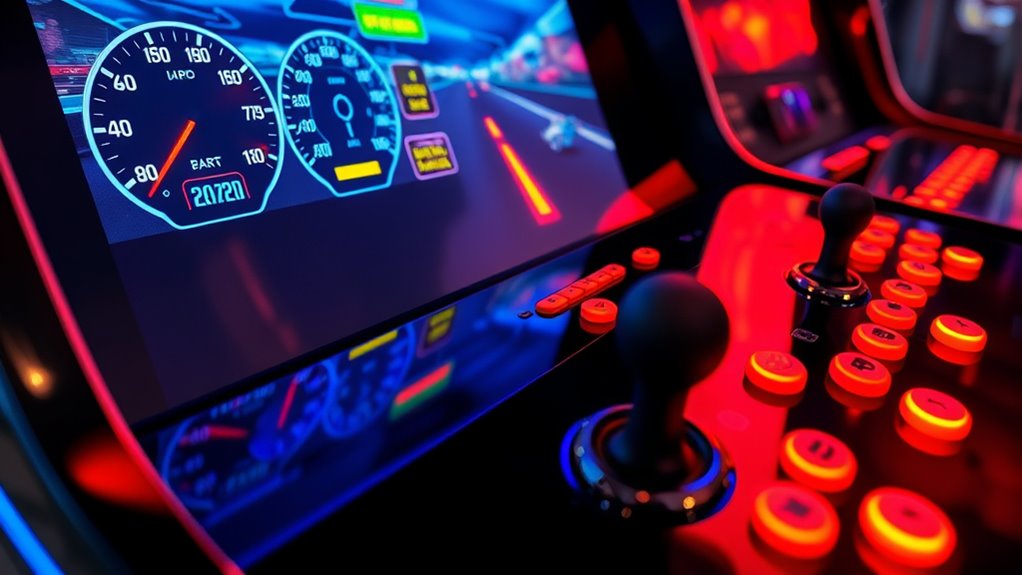
The clarity and responsiveness of screen technology play a crucial role in shaping your racing experience, as they directly influence how quickly and accurately you can interpret visual cues. Holographic displays offer immersive visuals that make you feel like you’re inside the race, enhancing depth perception and spatial awareness. Augmented reality overlays digital information onto real-world visuals, providing real-time data on speed, track layout, or competitor positions. These advanced visual cues help you anticipate turns and adjust your steering with precision, reducing reaction time. High-refresh-rate screens ensure smooth motion, minimizing lag and motion blur. Together, holographic displays and augmented reality create a more realistic, engaging environment, enabling you to respond instinctively and stay focused on the race, ultimately improving your performance. visual cues play a vital role in enhancing your overall racing accuracy and reaction times.
Integrating Software Algorithms With Hardware for Authentic Experience
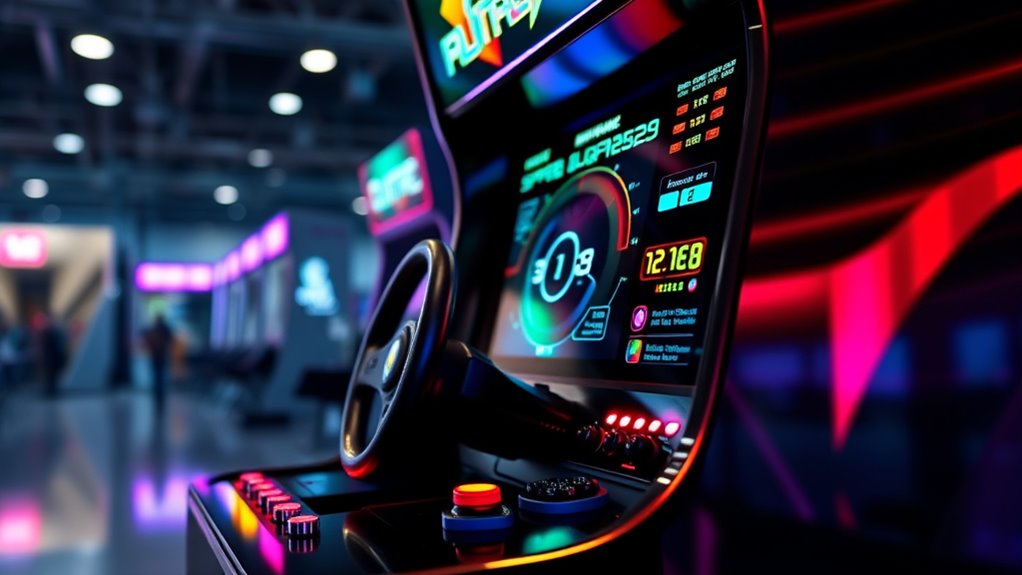
To create an authentic racing experience, you need to incorporate software algorithms seamlessly with hardware components. Precise sensor integration guarantees your controls respond accurately to your inputs, while realistic force feedback mimics real-world sensations. Together, these elements make the gameplay feel more immersive and true to life. Additionally, understanding the resources and tools available can help optimize your setup for the best possible performance.
Precise Sensor Integration
Achieving an authentic racing experience hinges on the precise integration of sensors with advanced software algorithms. You need to focus on sensor calibration to guarantee accurate readings, which directly affects responsiveness and realism. Proper calibration accounts for environmental factors like temperature, humidity, and electrical noise that can skew sensor data. By fine-tuning these sensors, you ensure that the hardware communicates precise information about steering, acceleration, and braking inputs. This seamless data flow allows the software to interpret commands accurately, resulting in smooth, realistic gameplay. Consistent calibration routines help maintain sensor accuracy over time, preventing drift and misinterpretation. Ultimately, meticulous integration of hardware and software enhances the authenticity of the racing experience, making every turn and acceleration feel true to life.
Realistic Force Feedback
Integrating software algorithms with hardware is essential for creating realistic force feedback in racing arcade cabinets. This synergy enables precise haptic feedback and authentic force simulation, immersing you in the racing experience. By combining advanced algorithms with sturdy motors, you feel every turn, bump, and acceleration accurately.
- Fine-tune force responses based on real-time data to mimic vehicle dynamics
- Use adaptive algorithms to adjust haptic feedback for different surfaces and conditions
- Synchronize force feedback with visual cues for a seamless experience
This integration ensures that every vibration and resistance aligns with the game’s physics, enhancing realism. When done correctly, it transforms the cabinet into a true extension of the vehicle, making your racing experience more immersive and authentic.
Frequently Asked Questions
How Do Arcade Cabinets Replicate Real Vehicle Inertia?
You experience realistic vehicle inertia in arcade cabinets through force feedback and motion simulation. The system uses motors to create resistance, mimicking how a real car feels when accelerating, braking, or turning. By adjusting these forces in real-time based on your actions, the cabinet replicates the inertia of a real vehicle, making your driving experience more immersive and believable. This combination of force feedback and precise motion control enhances realism effectively.
What Role Does Friction Play in Racing Cabinet Physics?
Friction plays a vital role in racing cabinet physics by simulating tire grip and surface texture. When you steer or accelerate, the friction between the virtual tires and the track surface determines how much control you have. Higher tire grip and rough surface textures increase friction, making your movements more responsive and realistic. This helps you feel the car’s behavior accurately, enhancing immersion and gameplay precision.
How Are Environmental Factors Simulated in Arcade Racing Setups?
In arcade racing setups, environmental factors like weather simulation and tire wear are simulated to create a realistic experience. You notice weather effects such as rain or fog, which impact grip and handling, while tire wear affects performance over time. These simulations incorporate sensors and software algorithms to mimic real-world conditions, making your gameplay more immersive and challenging by adjusting traction and vehicle behavior based on simulated weather and tire status.
Can Arcade Cabinets Adjust Physics Based on Player Skill Level?
You might wonder if arcade cabinets can modify physics based on your skill level. Many modern setups incorporate dynamic difficulty and adaptive feedback, which tweak game physics and response to match your performance. This means the game can become more challenging or easier, providing a personalized experience. By adjusting physics dynamically, the system keeps you engaged, helps improve your skills, and ensures the game remains fun and challenging regardless of your expertise.
How Do Sound Systems Contribute to the Physics Experience?
You might not realize it, but sound systems play a vital role in the physics experience. Through sound amplification and audio feedback, they create an immersive environment that mimics real racing sensations. When engine roars or tire squeals are amplified, they reinforce the sense of speed and movement, making you feel like you’re truly behind the wheel. This auditory cue enhances your perception of physics, heightening realism and engagement in the game.
Conclusion
As you step into a racing arcade cabinet, you experience the thrill of realism—yet behind the scenes, complex physics and precise mechanics work tirelessly. The tactile feedback and visual cues create immersion, but they’re built on intricate sensors and algorithms. It’s a dance between raw mechanical force and digital precision, reminding you that while the adrenaline feels real, it’s the unseen science that drives this exhilarating experience.
